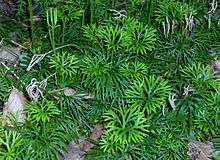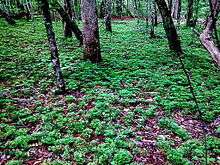Diphasiastrum digitatum
Diphasiastrum digitatum is known as groundcedar, running cedar or crowsfoot, along with other members of its genus, but the common name fan clubmoss can be used to refer to it specifically. It is the most common species of Diphasiastrum in North America. It is a type of plant known as a clubmoss, which is within one of the three main divisions of living vascular plants. It was formerly included in the superspecies Diphasiastrum complanatum. For many years, this species was known as Lycopodium flabelliforme or Lycopodium digitatum.[2][3]
| Diphasiastrum digitatum | |
|---|---|
 | |
| Scientific classification | |
| Kingdom: | Plantae |
| Clade: | Tracheophytes |
| Clade: | Lycophytes |
| Class: | Lycopodiopsida |
| Order: | Lycopodiales |
| Family: | Lycopodiaceae |
| Genus: | Diphasiastrum |
| Species: | D. digitatum |
| Binomial name | |
| Diphasiastrum digitatum | |
| Synonyms[1] | |
| |
Its common name is due to its resemblance to cedar boughs lying on the ground. Its leaves are scale-like and appressed, like a mature cedar, and it is glossy and evergreen. It normally grows to a height of about four inches (10 cm), with the spore-bearing strobili held higher. This plant was once widely harvested and sold as Christmas greenery, and populations were widely depleted for this reason. However, it has recovered throughout its range, and makes large clonal colonies, carpeting the forest floor.[4]
It prefers disturbed areas and coniferous forests, where it can form dense monocultures. The subterranean, brown gametophytes may live for years in the soil before developing vegetative shoots. According to expert sources its range is in the higher Appalachian mountains northward, and its range ends in northern Georgia and Alabama, but isolated stands have sprung up elsewhere.[reference needed, somewhat conflicting with range map below]
In the Appalachian Mountains of Southwest Virginia, the plant is known locally as "Bear's Paw." This species was also once one of the principal clubmoss species used for collection of Lycopodium powder, used as a primitive flashpowder.
Diphasiastrum digitatum is the accepted synonym of Lycopodium digitatum. Diphasiastrum digitatum, is also known commonly as Southern Ground Cedar, Fan Clubmoss, Running Pine, and Running Ground Cedar. Diphasiastrum digitatum lacks flowers or seed and is classified as a Lycopod.[5] They are commonly found in North America with a perennial life cycle and a sporulating season from July to October.
Description
Diphasiastrum digitatum is a perennial vascular plant that does not contain a significant amount of wood tissue above or at the ground. They are low-growing usually measuring less than 30 cm tall.[6] Leaves are evergreen, which appears opposite and is arranged spirally with 4 evenly spaced leaves, when viewed from the side it appears as 4 columns. The branch leaves are green and shiny, the base extends down to the stem (decurrent) and the free portion at the tip pointed and scale-like. Branches are shaped rectangular in cross-section, flattened on the underside with the associated leaf much smaller that the rest. The largest leaves are lateral, the free portion appressed to spreading, and the leaves on the upper surface are appressed and are more narrow. The stems spread horizontally above ground or just below the surface of the duff layer. The erect shoots each contains two or more branches near the base. Branches are more likely ascending to spreading, forked and tree-like, and mostly are arranged on the same plane, fan-like. Erect shoots can measure from 3 to 20 inches tall, although, vegetative shoots are typically less than 8 inches. Spores develop in a cone-like or structures referred to as strobili. About 2 to 4 strobili (rarely more) are usually clustered at the tip of a long stalk which is referred to as the peduncle.
Taxonomy
The species Diphasiastrum digitatum belongs to the kingdom Plantae. Its subkingdom is Trachaebionta, its division is Lycopodiophyta. It falls in the class Lycopoiosida, order Lycopodiales, family Lycopodiaceae and the genus is Diphasiastrum L.[7]
Distribution and Habitat
Diphasiastrum digitatum is present in dry to mesic and usually acid forests and openings. They are located in the eastern part of North America including parts of Canada such as Ontario and Quebec and south to Florida and Louisiana.There are a variety of habitats for Diphasiastrum digitatum, but they are usually found in a partially shaded habitat that is moist to dry. Typically habitats are open forest, thickets, and fields. The sporulating season tends to be from July to October.[8] Other habitats include upland woodlands, bluffs, sandstone cliffs, and abandoned sandy fields. They tend to be found in wooded areas where oak trees and conifers can also be found.[9]
Uses

Clubmosses or Lycophytes evolved about 410 million years ago as one of the earliest groups of vascular plants. There are numerous ways in which Diphasiastrum digitatum is used such as medicinal, pyrotechnic, and decorative purposes. Club moss spores and teas from plant leaves have been used since ancient times in both American Indian and European cultures. Medicinal uses included treating urinary tract problems, diarrhea and other digestive tract problems, relieving headaches and skin ailments, and inducing labor in pregnancy. In some cultures, the spores have been purported to be an aphrodisiac. The spores repel water and have been used as a powder on skin rashes and even on baby bottoms, and to treat wounds.Spores have been used historically as coating of pills. In the Americas and Europe, spores has been use as fabric dyes. Spores are also highly flammable due to the high content of oil that it contains. They have been used culturally for ceremonial purposes when medicine men tossed the spores into a fire for a flash of light. The spores ignite with a bright flash of light and were used in flash photography, in stage productions, in fireworks and in chemistry labs.[10] It is used for mainly bladder disorders, kidney disorders and other conditions. Although, more evidence is needed regarding effectiveness and safety.[11]
Cultivation
Diphasiastrum digitatum is very difficult to cultivate in the garden. Transplants are rarely successful, and the development of mature plants from spores is very slow (taking perhaps 20 years). They can be grown with frequent application of weak fertilizer solution under bright light, high humidity, and year-round moderate temperatures in greenhouses, growth chambers, and laboratories.[12] During its sexual phase, this species develops underground and requires the presence of appropriate fungi. It prefers a somewhat acidic soil that is sandy or rocky, dappled sunlight to light shade, and well-drained conditions.[13]
Etymology
Diphasiastrum: From the genus Diphasium and astrum for "incomplete resemblance;" so "false Diphasium".[14]
References
- "Family Lycopodiaceae, genus Lycopodium; world species list". Archived from the original on 2009-02-27. Retrieved 2015-07-27.
- United States Department of Agriculture Plants Profile
- Biota of North America Program 2014 state-level distribution map
- Flora of North America, Diphasiastrum digitatum (Dillenius ex A. Braun) Holub, 1975. Southern running-pine, lycopode en éventail
- "US Wildflower - Southern Ground Cedar, Fan Clubmoss, Running Pine, Running Ground Cedar - Diphasiastrum digitatum". uswildflowers.com. Retrieved 2018-12-07.
- "Growth Habits Codes and Definitions | USDA PLANTS". plants.usda.gov. Retrieved 2018-12-07.
- "Plants Profile for Lycopodium digitatum (fan clubmoss)". plants.usda.gov. Retrieved 2018-12-07.
- "Diphasiastrum digitatum (Southern Groundcedar): Minnesota Wildflowers". www.minnesotawildflowers.info. Retrieved 2018-12-07.
- "Fan Clubmoss (Diphasiastrum digitatum)". www.illinoiswildflowers.info. Retrieved 2018-12-07.
- "Clubmosses: An Ancient and Interesting Group of "Fern Allies" - Prince William Wildflower Society". Retrieved 2018-12-07.
- "Club Moss: Uses, Side Effects, Interactions, Dosage, and Warning". www.webmd.com. Retrieved 2018-12-07.
- "Home". www.bioone.org. doi:10.1640/0002-8444-104.2.25. Retrieved 2018-12-07.
- "Fan Clubmoss (Diphasiastrum digitatum)". www.illinoiswildflowers.info. Retrieved 2018-12-07.
- "Online Virtual Flora of Wisconsin - Diphasiastrum digitatum". wisflora.herbarium.wisc.edu. Retrieved 2018-12-07.
